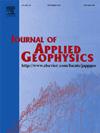Calibration of seismic parameters in the Zagros region, an application of generalized inversion technique
IF 2.2
3区 地球科学
Q2 GEOSCIENCES, MULTIDISCIPLINARY
引用次数: 0
Abstract
In this study, the Generalized Inversion Technique (GIT) was used to find seismic parameters (source and site effects) in the Zagros region, Iran. To this end, 91 events recorded at 205 three component accelerometers located in the Zagros region were analyzed. The dataset includes 745 acceleration waveforms in hypocentral distance range between 6 and 363 km and magnitude range between 5.0 and 7.3. All events included in the dataset were recorded between May 1997 and July 2022.
After applying a suitable processing procedure to prepare the data, near-surface high-frequency attenuation coefficient (Kappa) for both horizontal and vertical components was derived as 0.043 and 0.031, respectively. In the next step, the GIT was used to solve a linearized relationship and find spectra of site amplification and seismic source.
To find a parametric form for seismic source spectrum (, based on squared source model of Brune, 1970) and stress drop for each event, a Simple Grid Search routine was applied. The computed stress drop values were between 4 and 48.4 MPa for the west Zagros and 2 and 35 MPa for the east Zagros. The averaged values of stress drop for the west and east Zagros were 11.27 and 9.05 MPa, respectively.
Also, site amplifications derived from the H/V method were compared with the GIT results of site amplification at each station. This comparison showed that in the most stations the H/V method presents different amplification values than those of the GIT method. However, in the most stations resonance frequency reported by the H/V and the GIT methods were compatible.
The path effects including the quality factor and geometrical spreading model were adopted from Zafarani and Hassani (2013). Plotting seismic moment versus corner frequency showed that the Zagros events do not follow scaling rule of Aki (1967) completely. The decreasing rate of seismic moment versus corner frequency equals to 1.98 in logarithmic scale.
Derived between-event and within-event residual in each frequency through studied frequency range indicated that there is a negligible trend in residual values against magnitude and distance.
广义反演技术在Zagros地区地震参数标定中的应用
本文采用广义反演技术(GIT)在伊朗Zagros地区寻找地震参数(震源效应和场址效应)。为此,分析了位于扎格罗斯地区的205个三分量加速度计记录的91个事件。该数据集包括745个震源距离在6 ~ 363 km之间、震级在m5.0 ~ m7.3之间的加速度波形。数据集中的所有事件都记录在1997年5月至2022年7月之间。采用合适的处理程序制备数据后,得到水平分量和垂直分量的近地表高频衰减系数Kappa分别为0.043和0.031。下一步,利用GIT求解线性化关系,求出场地放大和震源的谱。为了找到震源谱(fcandγ,基于Brune, 1970的ω平方震源模型)和每个事件的应力降的参数形式,应用了一个简单的网格搜索程序。计算得到的应力降值在Zagros西部为4 ~ 48.4 MPa, Zagros东部为2 ~ 35 MPa。扎格罗斯西部和东部的应力降平均值分别为11.27和9.05 MPa。同时,将H/V法得到的位点扩增结果与各位点的GIT扩增结果进行比较。结果表明,H/V法与GIT法在大多数台站的扩增值不同。然而,在大多数台站,H/V法和GIT法报告的共振频率是一致的。路径效应包括质量因子和几何扩散模型,采用Zafarani和Hassani(2013)。绘制地震矩-角频率图表明,Zagros事件不完全遵循Aki(1967)的标度规则。地震弯矩随弯角频率的衰减率在对数尺度上为1.98。通过所研究的频率范围推导出每个频率的事件间和事件内残差,表明残差值对震级和距离的变化趋势可以忽略不计。
本文章由计算机程序翻译,如有差异,请以英文原文为准。
求助全文
约1分钟内获得全文
求助全文
来源期刊

Journal of Applied Geophysics
地学-地球科学综合
CiteScore
3.60
自引率
10.00%
发文量
274
审稿时长
4 months
期刊介绍:
The Journal of Applied Geophysics with its key objective of responding to pertinent and timely needs, places particular emphasis on methodological developments and innovative applications of geophysical techniques for addressing environmental, engineering, and hydrological problems. Related topical research in exploration geophysics and in soil and rock physics is also covered by the Journal of Applied Geophysics.
 求助内容:
求助内容: 应助结果提醒方式:
应助结果提醒方式:


